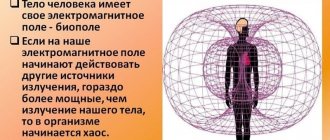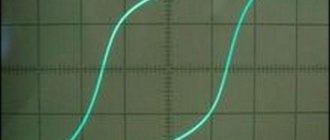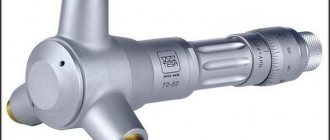In the core of any electromagnet, after turning off the current, part of the magnetic properties, called residual magnetism, always remains. The amount of residual magnetism depends on the properties of the core material and reaches a higher value for hardened steel and a lower value for soft iron.
However, no matter how soft the iron is, residual magnetism will still have a certain effect if, according to the operating conditions of the device, it is necessary to remagnetize its core, that is, demagnetize to zero and magnetize in the opposite direction.
Indeed, with any change in the direction of the current in the winding of an electromagnet, it is necessary (due to the presence of residual magnetism in the core) to first demagnetize the core, and only after that can it be magnetized in a new direction. This will require some kind of magnetic flux in the opposite direction.
In other words, the change in the magnetization of the core (magnetic induction) always lags behind the corresponding changes in the magnetic flux (magnetic field strength) created by the winding.
This lag of magnetic induction from the magnetic field strength is called hysteresis. With each new magnetization of the core, in order to destroy its residual magnetism, it is necessary to act on the core with a magnetic flux of the opposite direction.
In practice, this will mean spending some part of the electrical energy to overcome the coercive force, which makes it difficult to rotate the molecular magnets to a new position. The energy spent on this is released in the iron in the form of heat and represents losses due to magnetization reversal, or, as they say, losses due to hysteresis.
Based on the foregoing, iron that is subject to continuous magnetization reversal in a particular device (armature cores of generators and electric motors, transformer cores) should always be selected as soft, with a very small coercive force. This makes it possible to reduce hysteresis losses and thereby increase the efficiency of an electrical machine or device.
A hysteresis loop is a curve depicting the dependence of magnetization on the external field strength. The larger the loop area, the more work must be spent on magnetization reversal.
Let's imagine a simple electromagnet with an iron core. We will carry it through a full magnetization cycle, for which we will change the magnetizing current from zero to the OM value in both directions.
Initial moment: current strength is zero, iron is not magnetized, magnetic induction B = 0.
1st part: magnetization by changing the current from 0 to a value of - + OM. The induction in the core iron will increase quickly at first, then more slowly. By the end of the operation, at point A, the iron is so saturated with magnetic lines of force that further increasing the current (above + OM) can give the most insignificant results, which is why the magnetization operation can be considered completed.
Magnetization to saturation means that the molecular magnets present in the core, which were in complete and then only partial disorder at the beginning of the magnetization process, are now almost all arranged in orderly rows, with north poles in one direction, south poles in the other, why are we at one end of the core? Now we have northern polarity, on the other - southern polarity.
2nd part: weakening of magnetism due to a decrease in current from + OM to 0 and complete demagnetization at current - OD. Magnetic induction, changing along the AC curve, will reach the OS value, while the current will already be zero. This magnetic induction is called residual magnetism, or residual magnetic induction. To destroy it, for complete demagnetization, it is necessary to give a current in the opposite direction to the electromagnet and bring it to the value corresponding to the ordinate OD in the drawing.
3rd part: magnetization in the opposite direction by changing the current from - OD to - OM1. Magnetic induction, increasing along the curve DE, will reach point E, corresponding to the moment of saturation.
4th part: weakening of magnetism by gradually reducing the current from - OM1 to zero (residual magnetism OF) and subsequent demagnetization by changing the direction of the current and bringing it to a value of + OH.
5th part: magnetization corresponding to the process of the 1st part, bringing magnetic induction from zero to + MA by changing the current from + OH to + OM.
When the demagnetizing current decreases to zero, not all elementary or molecular magnets return to the previous disordered state, but some of them retain their position corresponding to the last direction of magnetization. This phenomenon of retardation or delay of magnetism is called hysteresis.
Source: electricalschool.info
General concepts of hysteresis
Hysteresis can be observed at those moments when a body in a specific period of time is dependent on external conditions. This state of the body is also considered at the previous time, after which a comparison is made and a certain relationship is derived.
A similar dependence is clearly visible in the example of the human body. To change his condition, you will need some period of time for relaxation. Therefore, the body’s reaction will always lag behind the reasons that caused the altered state. This lag is significantly reduced if changes in external conditions are also observed. However, in some cases, backlog reduction may not occur. As a result, an ambiguous dependence of quantities arises, known as hysteresis, and the phenomenon itself is called hysteresis.
This physical quantity can occur in a variety of substances and processes, but the concepts of dielectric, magnetic and elastic hysteresis are most often considered. Magnetic hysteresis usually appears in magnetic substances, such as ferromagnets. A characteristic feature of these materials is spontaneous or spontaneous inhomogeneous magnetization, which clearly demonstrates this physical phenomenon.
The mechanism of occurrence of the hysteresis loop
Hysteresis itself is a curve representing the changed magnetic moment of a substance that is affected by periodically changing field strength. When a magnetic field acts on ferromagnets, the change in their magnetic moment does not occur immediately, but with a certain delay.
Every ferromagnet initially has spontaneous magnetization. The material itself includes individual fragments, each of which has its own magnetic moment. When these moments are directed in different directions, the value of the total moment turns out to be zero as a result of mutual compensation.
If a ferromagnet is exposed to a magnetic field, then all the moments present in individual fragments (domains) will be deployed along the external field. As a result, a certain general moment is formed in the material, directed in one direction. If the external action of the field ceases, then not all domains will be in their original position. This will require exposure to a sufficiently strong magnetic field designed to rotate the domains. Such a reversal is hampered by the presence of impurities and heterogeneity of the material. Therefore, the material has some residual magnetization, even when the external field is turned off.
Application of hysteresis in electrical engineering and electronics
The magnetization of materials and the characteristics of transient processes should be taken into account when creating motors and transformers. When operating this equipment in alternating current circuits, part of the electricity consumed must be used to remagnetize the installed core. Similar phenomena are observed during the operation of switching devices. The study of hysteresis helps increase the efficiency of power machines and voltage converters and ensure the required relay switching speed.
Schmidt trigger
The figure shows the transfer characteristic of a Schmidt trigger. Changing the output signal with a certain delay is used to eliminate errors in the transmission of information. A conventional inverter responds to impulse noise by immediately switching. In this case, the time delay serves as a useful filter. It helps to correctly perceive control signals in difficult operating conditions.
Such solutions are used in electronics to eliminate problems with contact bounce. The calculated slowdown in operating reactions can be explained using a typical thermostat. If such a device is designed without hysteresis, switching will occur too often. However, in real conditions (room heating), an accuracy of ±3°C is quite sufficient. By increasing the width of the loop, you can set the optimal range to maintain a given temperature.
Description of the phenomenon of magnetic hysteresis
We know that the magnetic flux produced by an electromagnetic coil is the amount of magnetic field or lines of force produced in a given area, and that it is more commonly referred to as "flux density", symbolized B with the Tesla unit , T.
We also know from previous lessons that the magnetic strength of an electromagnet depends on the number of turns of the coil, the current flowing through the coil, or the type of core material used, and if we increase either the current or the number turns out, we can increase the magnetic field strength H.
Previously, relative permeability, symbol µ r, was defined as the ratio of absolute permeability µ and free space permeability µ o (vacuum), and this was specified as a constant. However, the relationship between the flux density B and the magnetic field strength H can be determined by the fact that the relative permeability µr is not a constant but a function of the magnetic field intensity, giving the magnetic flux density as: B = MH .
The magnetic flux density in the material will then be increased to a greater extent as a result of its relative permeability to the material compared to the magnetic flux density in a vacuum, µ o H, and for an air-core coil this ratio is given by:
Thus, for ferromagnetic materials, the ratio of flux density to field strength (B/H) is not constant, but varies with flux density. However, for air-core coils, or any core with a non-magnetic medium such as wood or plastic, this ratio can be considered a constant, and this constant is known as μo, the free space permeability ( μo = 4.π.10 - 7 h/m ).
By plotting the values of flux density (B) against field strength, (H) we can produce a set of curves called magnetization curves , magnetic hysteresis curves or more commonly BH curves for each type of base material used.
Single-domain ferromagnets
If the particles have different sizes, a rotation process occurs. This happens due to the fact that the formation of new domains is unfavorable from an energy point of view. But the process of particle rotation is hampered by anisotropy (magnetic). It can have different origins - form in the crystal itself, arise as a result of elastic stress, etc.). But it is precisely with the help of this anisotropy that the magnetization is retained by the internal field. It is also called the effective magnetic anisotropy field. And magnetic hysteresis occurs due to the fact that magnetization changes in two directions - forward and reverse. During the magnetization reversal of single-domain ferromagnets, several jumps occur. The magnetization vector M turns towards the field H. Moreover, the rotation can be uniform or inhomogeneous.
Magnetization or BH curve
The set of magnetization curves above provides an example of the relationship between B and H for soft iron and steel cores, but each type of core material will have its own set of magnetic hysteresis curves. You may notice that the flux density increases in proportion to the field strength until it reaches a certain value where it can no longer become nearly equal and constant as the field strength continues to increase.
This is because there is a limit to the amount of flux density that can be generated by the core since all the domains in the iron are perfectly aligned. Any further increase will not affect the value of M, and the point on the graph where the flux density reaches its limit is called magnetic saturation, also known as core saturation, and in our simple example above the saturation point of the steel curve begins at about 3000 ampere turns at meter.
Saturation occurs because, as we remember from the previous article on magnetism, which included Weber's theory, the random arrangement of the molecular structure in the core material changes when the tiny molecular magnets in the material become "aligned."
As the magnetic field strength (H) increases, these molecular magnets become more and more aligned until they reach perfect alignment, producing maximum flux density, and any increase in magnetic field strength due to increased electric current flowing through the coil will have will have little or no effect.
Examples of problem solving
EXAMPLE 1
| Exercise | Explain why ferromagnets, during cyclic magnetization reversal, heat up the more, the more pronounced their hysteresis is. |
| Solution | Let us consider a ferromagnet whose hysteresis is shown in Fig. 2. As the induction increases from to, work is done that is equal to the area limited by branch of the magnetization curve 1, that is, the area. When demagnetized to the initial state, the work returned is equal to the area, which is obviously smaller. Thus, during a full cycle of magnetization reversal of our ferromagnet, energy equal to W is introduced to each unit volume of the substance, and: where S is the area of the hysteresis loop. This energy is spent doing work against coercive forces in a ferromagnet and, as a result, turns into heat. Consequently, ferromagnets heat up the more, the stronger their hysteresis. |
EXAMPLE 2
| Exercise | Why is hysteresis heat taken into account when calculating electrical appliances and devices? |
| Solution | The heat of hysteresis must be taken into account when calculating various electrical devices if they contain ferromagnets, which are subject to magnetization reversal during operation of the device. (see example 1). Examples of such devices are iron cores of transformers, iron armatures of DC generators. The existence of hysteresis in them leads to a waste of energy released in the form of heat, which reduces the efficiency of devices and installations. To reduce unnecessary waste, soft iron grades are used whose hysteresis loops are minimal, that is, hysteresis is weak. |
In electrical engineering there are various devices whose operating principle is based on electromagnetic phenomena. Where there is a core on which a coil of conductive material, such as copper, is wound, interactions due to magnetic fields are observed. These are relays, starters, contactors, electric motors and magnets. Among the characteristics of cores there is such a characteristic as hysteresis. In this article we will look at what it is, as well as the benefits and harms of this phenomenon.
Storability (ability to retain residual magnetism)
Let's assume that we have an electromagnetic coil with high field strength due to the current flowing through it, and that the ferromagnetic core material has reached its saturation point, the maximum flux density. If we now open the switch and remove the magnetizing current flowing through the coil, we expect the magnetic field around the coil to disappear when the magnetic flux decreases to zero.
However, the magnetic flux does not disappear completely because the electromagnetic core material still retains some of its magnetism even when the current stops flowing in the coil. This ability of the coil to retain some of its magnetism inside the core after the magnetization process has stopped is called retention or remanence, while the amount of flux density still remains in the core is called remanent magnetism BR.
The reason for this is that some of the tiny molecular magnets do not return to a completely random pattern and still point in the direction of the original magnetizing field, giving them a kind of "memory". Some ferromagnetic materials have high specific retention (magnetic hardness), making them excellent for making permanent magnets.
While other ferromagnetic materials have low holding capacity (magnetic soft), making them ideal for use in electromagnets, solenoids or relays. One way to reduce this residual flux density to zero is to change the direction of the current flowing through the coil by changing the value of H, the magnetic field strength, to negative. This effect is called coercivity .
If this reverse current increases further, then the flux density will also increase in the opposite direction until the ferromagnetic core reaches saturation again, but in the opposite direction from the previous one. Reducing the magnetizing current I again to zero will create a similar amount of residual magnetism, but in the opposite direction.
Then, by constantly changing the direction of the magnetizing current through the coil from a positive direction to a negative direction, as is the case with an AC source, a magnetic hysteresis of the ferromagnetic core can be created.
Error
In electronics, hysteresis can also harm the operation of some devices. This effect is called hysteresis error. Often this effect can be observed with a motion sensor. For example, when an object moves from point A to point B, the sensor is triggered within 1 second. And when moving in the opposite direction while maintaining the trajectory, the sensor turns on with a slowdown of 2 seconds. The reason for this phenomenon lies in the difference in output signals for input signals, which differ in magnitude when decreasing and increasing. When moving from point A to point B, the value of the incoming signal has a difference of 30 MB from the value of the same signal when moving in the opposite direction. Taking into account the sensor sensitivity of 15 MB/mm, the hysteresis will be 3 mm. The difference in signal magnitude depends on changes in air temperature, external interference, the effect of friction or contact bounce.
Magnetic hysteresis loop
The magnetic hysteresis loop above shows the behavior of the ferromagnetic core graphically as the relationship between B and H is non-linear. Starting with a non-magnetic core, both B and H will be at zero, point 0 on the magnetization curve.
If the magnetizing current I increases in the positive direction to a certain value, the magnetic field strength H increases linearly with I, and the flux density B will also increase, as shown by the curve from point 0 to point a as it moves toward saturation.
Now, if the magnetizing current in the coil is reduced to zero, the magnetic field circulating around the core is also reduced to zero. However, the magnetic flux of the coils will not reach zero due to the residual magnetism present in the core and this is shown in the curve from point a to point b .
To reduce the flux density at point b to zero, it is necessary to reverse the current flowing through the coil. The magnetizing force that must be applied to nullify the residual flux density is called "Coercive force". This coercive force changes the magnetic field, rearranging the molecular magnets until the core becomes non-magnetic at point c .
Increasing this reverse current causes the core to magnetize in the opposite direction, and further increasing this magnetizing current will cause the core to reach its saturation point, but in the opposite direction, point d on the curve.
This point is symmetrical to point b . If the magnetizing current is again reduced to zero, the remanent magnetization present in the core will be equal to the previous value, but at point e will be the reverse.
Again reversing the direction of the magnetizing current flowing through the coil this time in the positive direction will cause the magnetic flux to reach zero, point f on the curve, and as before, further increasing the magnetizing current in the positive direction will cause the core to saturate at point A .
The BH curve then follows the path abcdefa as the magnetizing current flowing through the coil alternates between positive and negative values, such as an AC voltage cycle. This path is called a magnetic hysteresis loop .
The effect of magnetic hysteresis shows that the process of magnetization of a ferromagnetic core and therefore the flux density depends on which part of the curve the ferromagnetic core is magnetized to, since this depends on the past circuits giving the core its "memory" shape. Ferromagnetic materials then have memory because they remain magnetized after the external magnetic field has been removed.
However, soft ferromagnetic materials such as iron or silicon steel have very narrow magnetic hysteresis loops, resulting in very small amounts of residual magnetism, making them ideal for use in relays, solenoids and transformers as they can be magnetized and demagnetized easily.
Since a coercive force must be applied to overcome this residual magnetism, work must be done to close the hysteresis loop so that the energy used is dissipated as heat in the magnetic material. This heat is known as hysteresis loss, the amount of loss depends on the value of the material's coercive force.
By adding additives to metallic iron, such as silicon, it is possible to obtain materials with very low coercivity that have very narrow hysteresis loops. Materials with narrow hysteresis loops are easily magnetized and demagnetized and are known as soft magnetic materials.
Magnetic hysteresis loops for soft and hard materials
Magnetic hysteresis results in the dissipation of wasted energy in the form of heat, with energy lost in proportion to the area of the magnetic hysteresis loop. Hysteresis losses will always be a problem in AC transformers where the current is constantly changing direction and thus the magnetic poles in the core will cause losses because they are constantly changing direction.
The rotating coils in DC machines will also suffer hysteresis losses as they alternately pass north of the south magnetic poles. As stated earlier, the shape of the hysteresis loop depends on the nature of the iron or steel used, and in the case of iron that undergoes massive changes in magnetism, such as transformer cores, it is important that the BH hysteresis loop is as small as possible.
In the next article on electromagnetism, we will look at Faraday's law of electromagnetic induction and see that by moving a wire in a stationary magnetic field, we can induce an electric current in the conductor, forming a simple generator.
Timerkaev Boris is a 68-year-old doctor of physical and mathematical sciences, professor from Russia. He is the head of the department of general physics at the Kazan National Research Technical University named after A. N. TUPOLEV - KAI
Source: meanders.ru
Types of hysteresis in physics
What is the source of the magnetic field
To solve practical electrical problems, magnetic hysteresis should be studied in detail. A complete understanding of similar phenomena based on physical principles can be obtained after considering ferroelectric and elastic processes.
Magnetic hysteresis
According to the basic definition, this phenomenon refers to the lag of the magnetization (M) of a material from the changing influence of an external field. For the experiment, you can assemble a circuit in which current is passed through a solenoid. The voltage level (H) is adjusted using a parallel variable resistor. The core is made of ferromagnet.
Experimental setup diagram
Important! The presented dependencies should be considered in conjunction with the graph in the first figure.
Before the experiment begins, the sample has neutral characteristics. Magnetization and intensity are zero, the magnetic moments of the domains are randomly located. After closing the circuit and increasing the current, the voltage increases. The figure shows how at the same time the direction of the moments changes. The induction in the sample ( B ) is equal to the sum of the voltage and magnetization with a correction factor (μ0):
B = μ0*H + μ0*M.
At a certain level, the μ0*M indicator increases to a maximum value. A subsequent change in the external field strength does not have any effect on it.
Ferroelectric hysteresis
The reason for the special shape of the graph in this example is the formation of polarization without the application of external field forces. This effect is observed in a certain temperature range. The corresponding materials are called ferroelectrics.
Ferroelectrics
The first figure shows the hysteresis loop, where the places are marked:
- point “a” – saturation state;
- Pc – residual polarization;
- -Ec – coercive force.
The second part (2) shows the chaotic (a) and directional (b) arrangement of domains. Orientation along electrostatic field lines is used to create capacitors with variable capacitance.
For your information. As in other substances, when the temperature rises to the level of the Curie point, magnetization disappears.
Elastic hysteresis
This phenomenon is explained by the special mechanical properties of individual materials. They retain the shape created by a fairly strong impact. A typical example is the manufacture of metal products using forging.
What does the hysteresis loop show?
HYSTERESIS - (from the Greek hysteresis lag) the delay of a change in a physical quantity characterizing the state of a substance (magnetization M of a ferromagnet, polarization P of a ferroelectric, etc.) from a change in another physical quantity that determines ... ... Big Encyclopedic Dictionary
hysteresis - shift, lag Dictionary of Russian synonyms. hysteresis noun, number of synonyms: 2 • lag (10) • ... Dictionary of synonyms
HYSTERESIS - HYSTERESIS, a phenomenon characteristic of elastic bodies; lies in the fact that the DEFORMATION of a body when STRESS increases is less than when it decreases due to a delay in the effect of deformation. When mechanical stress is completely removed, what remains is... ... Scientific and technical encyclopedic dictionary
Hysteresis - (from the Greek hysteresis lag, retardation) 1) G. in aerodynamics, the ambiguity of the structure of the flow field and, consequently, the aerodynamic characteristics of a streamlined body for the same values of kinematic parameters, but at ... ... Encyclopedia of Technology
HYSTERESIS - (from the Greek hysteresis lag, delay), a phenomenon that consists in the fact that physical. a quantity characterizing the state of a body (for example, magnetization) ambiguously depends on physical properties. quantity characterizing external conditions (eg magnetic fields). G...Physical Encyclopedia
HYSTERESIS - (hysteresis) The dependence of the equilibrium (equilibrium) state of the system on how adaptation (adjustment) is carried out in the process of dynamics. This approach undermines the traditional distinction between comparative statics and dynamics.... ... Economic Dictionary
Hysteresis is the assumption in economics that the current level of an economic variable depends on its past level. Dictionary of business terms. Akademik.ru. 2001 ... Dictionary of business terms
HYSTERESIS - (from the Greek hysteros later), the name given to a number of phenomena united by the common property that a certain value is dependent on the previous state of the system under study. G. magnetic. If you place an iron rod... ... Big Medical Encyclopedia
hysteresis - Delay in physical changes. quantities characterizing the state of a thing in relation to changes in external conditions (other physical quantities); depicted as a hysteresis loop. [https://metaltrade.ru/abc/a.htm] Topics: metallurgy in general EN hysteresis ... Technical Translator's Guide
Hysteresis - - (from the Greek hysteresis - delay) - a different reaction of physical. body to certain external influences, depending on whether this body has previously been exposed to the same influences or is being exposed to them for the first time. G. is explained... ... Encyclopedia of terms, definitions and explanations of building materials
In economics
Some economic systems show signs of hysteresis: for example, it may require significant effort to start exporting in an industry, but little effort to maintain it at a constant level.
In game theory, the hysteresis effect is manifested in the fact that small differences in one or more parameters lead two systems to opposite stable equilibria, for example, “good” - trust, honesty and high welfare; and “bad” - theft, mistrust, corruption and poverty. Despite small initial differences, systems require enormous effort to move from one equilibrium to another.
The hysteresis effect is a state of unemployment; Having reached a sufficiently high level, it can, to a certain extent, self-reproduce and remain there. The economic reasons for hysteresis (long-term labor market rigidity) are controversial. Some institutional factors lead to hysteresis. For example, social insurance, especially unemployment insurance, can, through the tax system, reduce firms' demand for labor in the formal economy.
Unemployment can lead to a loss of human capital and the “tagging” of those who remain unemployed for long periods of time. Unions can negotiate to maintain the welfare of their actual members while ignoring the interests of outsiders who find themselves unemployed. Fixed costs associated with changing positions, jobs, or industries can also lead to hysteresis.
Finally, there may be difficulties in distinguishing between real and apparent hysteresis phenomena when the final state of the system is determined by its current dynamics or its initial state. In the first case, hysteresis reflects our ignorance: by adding missing variables and information, we can more fully describe the evolution of the system being studied. Dr. the interpretation of the phenomenon of hysteresis is the simple existence of several equilibrium states when invisible influences move the economy from one equilibrium state to another.










